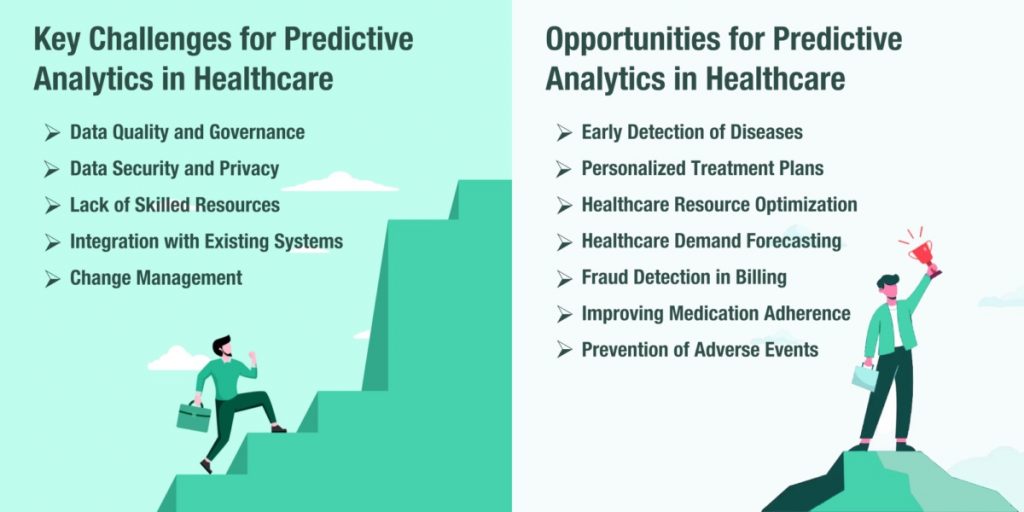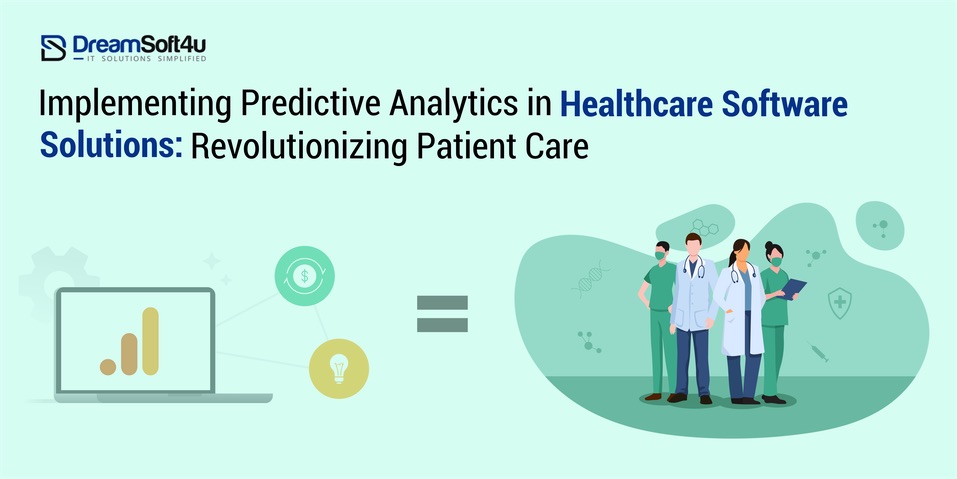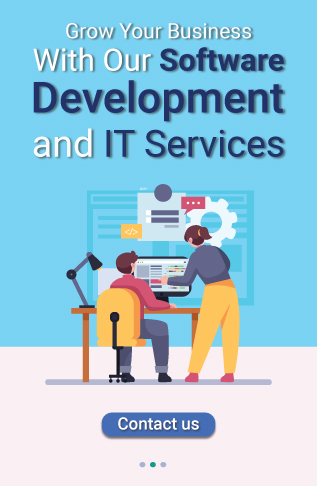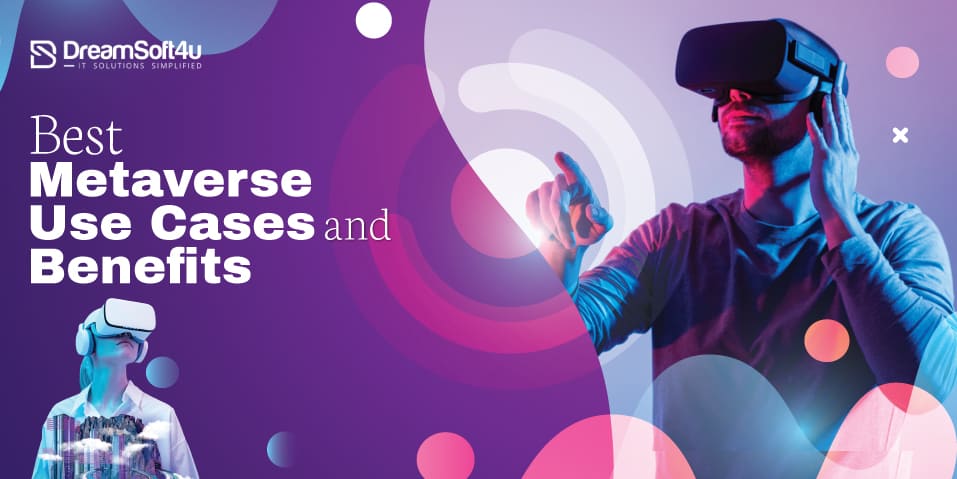Not having a full picture of the patient’s health history or current symptoms can be frustrating for healthcare providers. Healthcare software solutions are changing that by harnessing the power of predictive analytics.
Predictive analytics is changing the way doctors diagnose conditions and determine the best treatment plans. By leveraging data from sources like electronic health records, claims data, and wearable devices, predictive models can forecast health risks, suggest diagnoses, and predict outcomes.
The result is higher quality care, reduced costs, and better outcomes. Implementing predictive analytics in healthcare software development solutions gives doctors a crystal ball – helping them see into the future of a patient’s health and take action before issues arise or worsen.
Table of Contents
ToggleUnderstanding Predictive Analytics in Healthcare Software Development Solutions
Predictive analytics uses data to anticipate future outcomes and trends. By analyzing a patient’s medical history, lifestyle, and habits, healthcare providers can predict the likelihood of certain medical events and take preventative action.
Healthcare software development solutions are setting up a place for patient data from electronic health records, medical claims, prescriptions, and more. Using machine learning algorithms, this data can detect patterns to identify at-risk patients and forecast medical issues before they become severe.
Predictive analytics also helps determine the most effective, cost-efficient treatment plans based on a patient’s unique situation. By comparing the outcomes of similar patients, doctors can see which procedures or medications have the best results. This precision medicine approach revolutionizes the one-size-fits-all treatment model.
Benefits of Implementing Predictive Analytics in Healthcare Software Solutions
Implementing predictive analytics in healthcare software solutions provides major benefits for both providers and patients.
For providers, predictive analytics helps identify at-risk patients for timely intervention and care. By analyzing data like medical claims, prescriptions, and patient records, the software can predict the likelihood of certain medical events like hospital readmissions or the onset of chronic diseases. This allows for proactive steps to avoid complications and improve outcomes.
For patients, predictive analytics means higher quality, personalized care. Custom healthcare software solutions consider unique health profiles and risks to provide tailored treatment plans, reminders for preventative care, and lifestyle recommendations specific to you. This customized approach helps patients better manage chronic conditions and overall wellness.
Predictive analytics also reduces costs. By identifying at-risk patients early on, healthcare software development organizations can avoid expensive emergency room visits and hospitalizations. The software also helps streamline operations by optimizing staffing levels and resource allocation based on predicted patient volume and acuity.
In summary, implementing predictive analytics revolutionizes the way providers deliver care and how patients experience healthcare. The future of healthcare is here, and predictive analytics is leading the way.
Key Challenges and Considerations for Implementing Predictive Analytics
Implementing predictive analytics in healthcare software solutions comes with challenges that must be addressed. Some key considerations include:
Data Quality and Governance
The accuracy of predictive models depends primarily on data quality. Healthcare organizations must have proper data governance practices in place to ensure data is clean, complete, and consistent. Things like missing values, incorrect data types, and duplicate records can negatively impact model performance.
Data Security and Privacy
Healthcare data contains extremely sensitive personal information, so security and privacy are paramount. Strict data access controls need to be put in place. Guidelines like HIPAA, GDPR, and more must be followed to protect patient privacy when data is used for analytics.
Lack of Skilled Resources
Data scientists, data engineers, and healthcare experts with experience in predictive analytics are in high demand but in short supply. Healthcare software development companies may struggle to recruit and retain the specialized talent required to implement and scale predictive analytics initiatives. Some may need to invest in retraining existing staff or hiring consultants and vendors to help fill the gap.
Integration with Existing Systems
For predictive models to be useful, they must be integrated into the existing healthcare IT infrastructure like electronic health records systems, billing systems, and practice management software. Achieving seamless integration requires planning and collaboration across teams to determine how models will be deployed and used to support key workflows.
Change Management
Implementing predictive analytics in healthcare represents a major change, and staff may be hesitant to adopt new tools and processes. Comprehensive change management strategies are needed to demonstrate the value of predictive analytics, provide proper training, and get clinicians and staff on board. With time and experience, predictive analytics can become deeply embedded in the organization’s culture.

Best Practices for Implementing Predictive Analytics in Healthcare Software Solutions
To successfully implement predictive analytics in healthcare software solutions, follow these best practices:
Start with a Specific Use Case
Focus on a targeted area you want to improve, like reducing hospital readmissions or improving medication adherence. Have a clear problem statement and identify the metrics you’ll use to measure success. This focused approach will make your implementation more effective.
Choose Relevant Data Sources
Work with your IT team to identify data sources related to your use cases, such as electronic health records, insurance claims, patient surveys, and wearable devices. Don’t compromise on the data quality to build an accurate predictive model. You may need to clean and integrate data from multiple sources.
Select an Appropriate Algorithm
The most common algorithms for healthcare predictive analytics include regression, decision trees, neural networks, and ensemble methods. Evaluate different algorithms to determine which is most suitable for your use case, based on factors like data type, volume, and complexity. You may need to test multiple algorithms to find the best performer.
Validate and Refine the Model
Split your data into training and testing sets. Use the former to build the model and the latter to evaluate its performance. Check for high accuracy, precision, and recall. Look for any biases. Make adjustments to improve the model, then re-test. Repeat this process until you achieve the best possible predictions.
Monitor and Update Regularly
Once deployed, monitor your model’s predictions and actual outcomes to ensure it remains accurate over time as new data comes in and patient populations and treatments change. Be prepared to re-validate and re-train the model periodically to keep it optimized. Predictive analytics is an ongoing process.
With the right approach, predictive analytics can revolutionize patient care in your healthcare organization.
Real-world examples of Predictive Analytics in Healthcare Software Solutions
Several healthcare software solutions are leveraging predictive analytics to improve patient care. These include:
Software that Identifies At-risk Patients
Some solutions analyze patient data to identify those at high risk of disease or readmission. For example, a solution may analyze factors like age, medications, and prior hospital visits to predict the likelihood of readmission for congestive heart failure patients. Care managers can check in on high-risk patients and ensure proper follow-up care is scheduled.
Software that Optimizes Treatment Plans
Other healthcare software solutions use predictive analytics to help determine the best course of treatment based on a patient’s unique characteristics and history. For instance, a solution could analyze cancer patient data to predict how individuals may respond to different chemotherapy options.
Software That Improves Diagnostic Accuracy
By analyzing a large volume of data on symptoms, test results, diagnoses, and outcomes, healthcare software solutions can identify patterns that may improve the accuracy of diagnoses. For example, a solution could analyze data from emergency room patients with chest pain to determine which additional tests and questions may be most useful for determining if the pain is due to a heart attack or another cause.
The opportunities for enhancing patient care through predictive analytics are vast. The future of healthcare apps will be shaped by the creative use of data to provide personalized, proactive, and optimized care for all.
Future Trends and Innovations in Healthcare Software Solutions
AI and Machine Learning
Continued progress in AI in healthcare and real-time data will help transform patient care and improve outcomes. Cloud-based custom healthcare software solutions and automated machine learning tools will make predictive analytics more accessible to smaller clinics and healthcare startups.
Real-Time Predictive Analytics
Real-time data from wearable devices and mobile apps will further enhance predictive analytics impact. It will be possible to detect alarming changes in patients’ conditions and alert their doctors right away. Moreover, Real-time predictions also enable just-in-time interventions to prevent adverse events.
Personalized Predictions
Predictive analytics will become more personalized using data like genetics, lifestyle, environment, and health history. Personalized predictive models will provide customized risk scores, treatment recommendations, and health management plans tailored to each patient’s needs.
The future of predictive analytics in healthcare is bright. Predictive analytics has the potential to make healthcare more proactive, preventive, and patient-centered. The possibilities for innovation in this space are endless.
Conclusion
Predictive analytics in healthcare software represents a significant change in patient treatment. Enabling the shift from reactive to proactive healthcare technology helps enhance the way for early intervention, preventative treatment, and individualized wellness management. Healthcare workers may anticipate patient requirements, refine treatment approaches, and ultimately improve health outcomes by utilizing data-driven insights.
Yet, it’s important to pay close attention to ethical issues about patient permission, bias mitigation, and data protection. Additionally, predictive analytics can reduce costs significantly; early intervention and well-allocated resources result in a more effective healthcare system. Predictive analytics has the revolutionary potential to completely change the way healthcare is delivered, bringing in a new era of tailored treatment and a healthier future for all, as it develops alongside artificial intelligence.
FAQs
1. What kind of data can be used for predictive analytics in healthcare software?
Numerous data sources, such as electronic health records (EHRs), patient demographics, test findings, prescription histories, wearable device data, and even socioeconomic determinants of health, may be included into predictive analytics. This combination allows Medical Software Development companies to identify patterns and predict potential health risks.
2. How can predictive analytics improve patient care?
Predictive analytics empowers proactive care by:
- Identifying patients at high risk for certain conditions allows for earlier intervention.
- Tailoring treatment plans based on individual patient data and risk factors.
- Predicting potential complications and readmission risks, enabling preventative measures.
- Assisting with medication management and flagging potential drug interactions.
3. Is predictive analytics replacing doctors?
Not at all! One effective way to improve a doctor’s abilities is through predictive analytics. It gives physicians the data-driven insights they need to make better decisions and spend more time interacting with patients individually.
4. What’s the future of predictive analytics in healthcare software?
The future seems promising! We may anticipate even more advanced uses as technology develops further, such as the deployment of artificial intelligence (AI) for more accurate risk assessment and individualized health advice.























